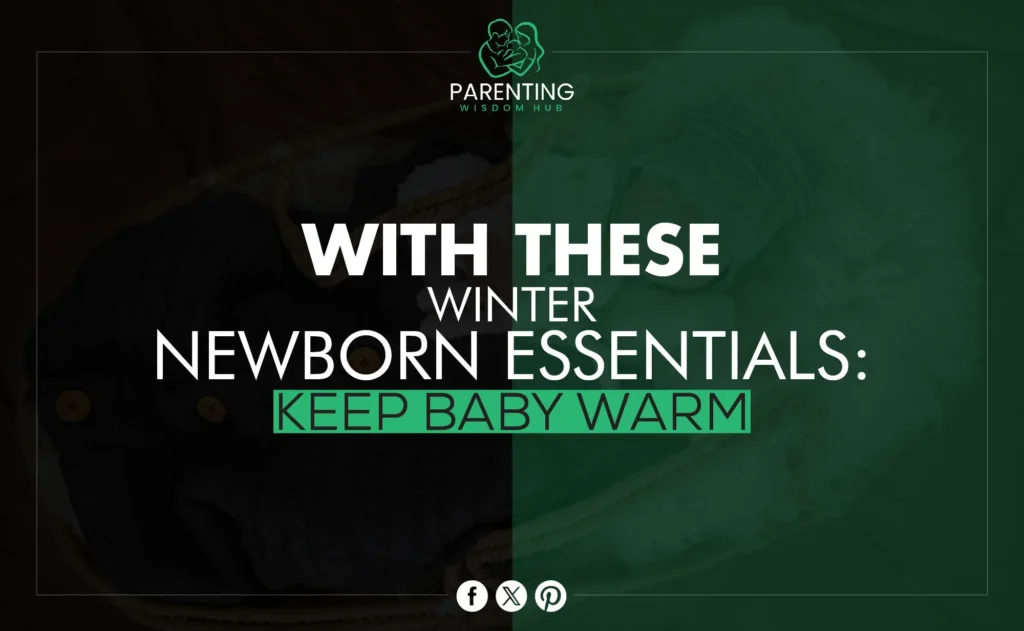Introduction
Winter’s cold may be scary when you’re caring for a baby. Keeping your baby warm is a primary consideration for new parents. This list covers winter newborn essentials. We offer practical ideas and must-have supplies to ensure your winter baby gear meets the challenge.
Why Newborns Need Extra Warmth
Baby’s Temperature Regulation
Newborns are especially sensitive to cold weather because their bodies are still learning to control their internal temperature. Babies don’t shiver to stay warm like adults do. To make things worse, this makes them more sensitive to changes in their surroundings, making them feel bad or even causing health problems like colds.
The Role of Layering
One of the best ways to keep your baby warm in the winter is to dress them in layers. Putting on lots of clothes isn’t enough; you also need to pick clothes made of the right materials to keep your child warm without making them too hot. Cotton and wool are great options because they keep you warm while letting air flow through them. Don’t forget that a baby who is well-layered is happy and relaxed.
Warning Signs of Overheating
Keeping your baby warm is important, but too much heat is also a problem. Watch for signs like red cheeks, wet hair, or being too fussy. You can find a good balance by checking your baby’s temperature often and removing layers.
Essential Winter Baby Gear
Swaddle Blankets
Swaddling is a tried-and-true way to calm a baby, and picking the right wrap blanket in the winter is very important. You should look for items made from warm, flexible materials that will keep your baby warm and safe. There are many styles of swaddle blankets, so you should be able to find one that fits your needs and style.
Footed Onesies and Sleepsuits
Any winter newborn outfit must include footed onesies. Instead of separate socks, which are easy to lose, these all-in-one clothes keep your baby’s feet warm and covered. To keep your baby as warm as possible all night, choose onesies made of wool or thick cotton.
Winter Hats and Mittens
People lose a lot of heat through their heads, so babies need to wear hats all winter. Choose hats that go over your ears and are made of soft, non-itchy materials. Mittens are also important because they warm little fingers and protect skin from scratching.
Smart Dressing Tips for Cold Weather
The Importance of Layering
Layering your baby’s clothes is a good way to keep them warm when the weather changes without making them uncomfortable. Begin with a swimsuit, follow with a long-sleeved shirt, and finish with a warm sweater or jacket. With this method, you can add or remove clothes to keep your baby at a safe temperature.
Using Sleep Sacks
Sleep sacks are a safe and easy way to keep babies warm in the crib instead of open blankets. They keep babies warm without the risk of smothering. They come in different widths that are good for various temperatures, so you can’t pick the right amount of warmth for your baby.
Outdoor Adventures
If you take your baby outside, cover all of its exposed skin. A warm snowsuit is the best way to keep your baby warm on walks or runs. Make sure that thick fabrics don’t cover your baby’s face because they can make it hard for them to breathe. Instead, use a car seat cover or bike blanket to keep warm.
Choosing the Right Fabrics
Benefits of Cotton and Wool
Think about the fabric when choosing winter newborn essentials. Cotton and wool are great picks because they keep you warm and let air flow through them. They help keep your baby warm, which is very important for comfort and safety in the winter.
Avoiding Irritating Materials
Since a baby’s skin is still soft, don’t put it in fabrics that might irritate or bother it. Avoid synthetic mixes, which don’t let enough air move and can cause skin rashes or burning.
The Role of Fleece
Another great winter clothing choice is fleece. The fact that it is light but warm makes it great for coats or warmer layers. Warmth without extra bulk is what fleece-lined jackets and pants are great for parents who are always on the go.
Must-Have Winter Accessories
Baby Carriers and Wraps
Baby wraps and slings are great ways to keep your baby close and warm, which is good for both the parent and the child. To keep your baby warm, choose wraps made of warmer materials, or consider getting a carrier cover.
Stroller Covers
Thanks to a stroller cover, your baby will be safe from wind and cold air while you’re out and about. Ensure you buy one that fits your stroller type and lets air flow through it to keep your baby safe and comfortable.
Booties and Socks
Stock up on booties and socks that stay in place because little feet can get cold very fast. Pick ones with elastic bands or openings that you can change so they don’t slip off. Wear socks under booties to keep your feet warmer when it’s cold outside.
Maintaining a Warm Home Environment
Setting the Right Temperature
It is very important for your baby’s comfort that your home stays at a steady temperature. The best temperature range is usually between 20°C and 72°F (68°C to 72°C). Keep the temperature at this level with a reliable timer to make sure your baby stays warm without getting too hot.
Humidity Control
The dry air in the winter can make your skin itch and your lungs hurt. A humidifier will make the air wetter, making your baby feel better overall. This also keeps their skin soft and stops it from getting dry.
Safe Sleep Practices
Do not put loose blankets or pillows in the crib. Use fitted baby covers and a sleep sack for warmth without the risk of smothering. To ensure your baby is safe while sleeping, always put them on their back.
Finding the Right Balance
Monitoring Your Baby’s Comfort
Feel your baby’s chest or back often to determine its temperature. If it’s too warm, take one off. If it’s too cold, add one. Trust your gut and make changes as needed to keep it comfortable.
Engaging in Skin-to-Skin Contact
Not only does skin-to-skin touch help you bond with your baby, but it also helps keep their body temperature stable. This simple action makes your baby feel safe and warm, which builds a strong mental bond between you and your baby.
Knowing When to Seek Help
Talk to your child’s doctor if you are worried about their temperature or any other signs that they might be sick. They can give you advice and encouragement, which will help keep your baby healthy and happy this winter.
Conclusion
With the right essentials and a few smart tactics, you can keep your baby warm, cozy, and happy during the winter months when it can be difficult to get around. Remember that every baby is different, so make these tips work for your child. For more help and specific information, you could contact parenting groups and tools to help you on this amazing path to becoming a parent.


